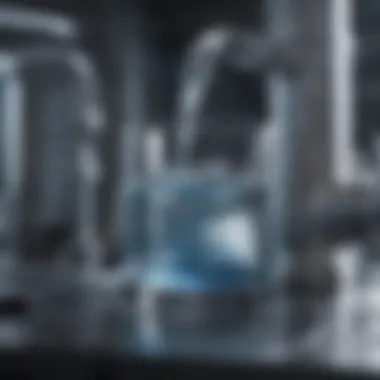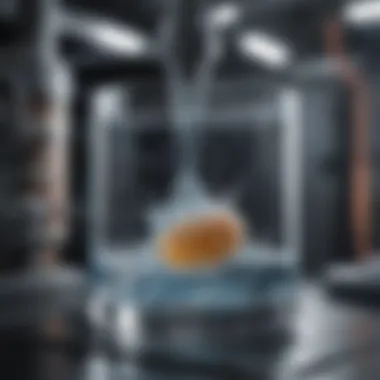Exploring Water Purification Processes and Technologies


Intro
Water is a fundamental resource for human life. Without access to clean water, health and well-being suffer. Understanding how to purify water effectively is essential for ensuring its safety. Water purification processes undergo continuous evolution, guided by advances in technology and research. This article offers a thorough examination of the diverse methods used for water purification and the relevance of these techniques in society today.
Research Overview
Summary of Key Findings
The study of water purification reveals several critical aspects. First, the importance of removing harmful contaminants cannot be overstated. Contaminants include biological pathogens, chemical pollutants, and physical impurities. Various methods have proven effective, including filtration, distillation, and chemical treatment. Each technique has its strengths and potential limitations based on the initial quality of water.
Background and Context
The journey of water purification began with simple practices in ancient civilizations where boiling water was a common method to kill pathogens. As technology advanced, so did the methods of purification. Modern approaches now incorporate complexity such as reverse osmosis and ultraviolet light treatment. The need for reliable water purification escalates due to climate change and population growth, making this topic increasingly relevant.
Methodology
Experimental Design
Recent research studies focus on comparing various purification methods. For example, a study may involve setting up experimental groups using different purification techniques on the same water source. This design allows for a comprehensive analysis of effectiveness and efficiency.
Data Collection Techniques
Data is typically gathered through quantifiable measures such as:
- Contaminant levels before and after purification.
- Consumer perceptions of water quality.
- Resource efficiency of each purification method used.
By maintaining rigorous data collection practices, researchers can contribute meaningful insights into the science of water purification.
Emerging technologies like nanofiltration and advanced oxidation are reshaping how we think about water purity. Studying these aspects offers guidance for future innovations and addresses pressing issues in water access.
Prologue to Water Purification
Water purification is a significant topic in the realm of environmental science and public health. Understanding the processes involved in purifying water is essential for ensuring that this vital resource remains safe and accessible for human consumption and ecological balance. As water pollution becomes increasingly prevalent due to industrial activities, agricultural runoff, and urban expansion, the need for effective purification methods is more pressing than ever.
In this section, we will focus on several important elements:
- The Basics of Water Purification: Understanding what water purification entails lays the foundation for further exploration of specific methods and technologies.
- Health and Environmental Benefits: Clean water contributes significantly to public health and ecosystem stability. Thus, the implications of effective purification are far-reaching.
- Considerations and Challenges: Various factors influence water treatment processes, such as contaminant types, geographical contexts, and technological advancements. It is crucial to recognize these challenges to develop holistic solutions.
By gaining insight into the basics of water purification, readers can better appreciate subsequent discussions surrounding its importance, methodologies, and technological innovations.
The Importance of Water Purification
Water purification serves a critical role in public health and environmental protection. It transforms contaminated water into safe, consumable resources, addressing both individual and global needs. The implications for human health and the environment are profound, making this topic essential for wide-ranging discussions in scientific and educational spheres.
Health Implications
Water is fundamental for life. Contaminated water can lead to severe health issues. Diseases such as cholera, dysentery, and typhoid fever primarily spread through unsafe drinking water. Any lack of purification increases the risks of infectious diseases.
Purification processes help by removing or killing pathogens. For instance, methods like chlorination and ultraviolet (UV) disinfection effectively eliminate harmful microorganisms. Additionally, clean water contributes to overall community health, leading to reduced healthcare costs and improved productivity.
Moreover, regular access to purified water can prevent waterborne illnesses. This directly ties to quality of life. Communities that ensure safe water supplies often report decreased medical expenditures and longer life expectancies. Therefore, understanding health implications is vital for guiding policies and practices around water management.
Environmental Impact
The environmental impacts of water purification are equally significant. Polluted water negatively affects ecosystems. It can lead to toxic algae blooms, harm aquatic life, and disrupt the food chain.
Implementing effective water purification techniques mitigates these detrimental effects. For example, constructed wetlands act as a natural filter, removing contaminants while providing habitat for wildlife. This creates a dual benefit: restoring ecological balance and enhancing local biodiversity.
Furthermore, responsible water purification practices help conserve freshwater resources. By treating wastewater, communities reclaim valuable water supplies for reuse. This promotes sustainability, which is increasingly crucial in the context of climate change.
In summary, the importance of water purification cannot be overstated. It is a key element to ensure public health and protect our environment, underscoring the need for effective systems that address various contamination challenges.
Common Contaminants in Water
Understanding common contaminants in water is essential for effective water purification. Each type of contaminant poses unique risks to human health and environmental integrity. Addressing these contaminants ensures the safety and quality of drinking water.
Biological Contaminants
Biological contaminants include a variety of microorganisms such as bacteria, viruses, and parasites. These pathogens can enter water sources through fecal contamination or improper treatment. The presence of these microorganisms can lead to serious health issues, including gastrointestinal infections.


Common biological contaminants include:
- E. coli: Often found in intestines of humans and animals.
- Giardia: A parasite that causes gastrointestinal illness.
- Cryptosporidium: Resistant to many treatment methods, this protozoan can survive in chlorinated water.
The removal of biological contaminants is critical to preventing waterborne diseases. Standard purification methods may not always eliminate these pathogens, which is why advanced techniques like UV disinfection or ozonation are often necessary.
Chemical Contaminants
Chemical contaminants encompass a broad category of harmful substances including pesticides, heavy metals, and industrial pollutants. These chemicals can originate from agricultural runoff, factory discharges, and urban waste. The complexity of chemical contaminants means that multiple treatment processes might be required to address them effectively.
Some notable chemical contaminants are:
- Lead: Often leaches into drinking water from old pipes.
- Nitrate: Common in agricultural regions, it can cause serious health issues, particularly for infants.
- Pesticides: These can enter water sources through agricultural runoff.
Each of these chemicals has its own health effects, ranging from neurological damage to reproductive issues. Therefore, understanding their presence and potential concentrations in water is fundamental in designing effective purification strategies.
Physical Contaminants
Physical contaminants primarily refer to particles that may not be visible to the naked eye. This category includes sediments, turbidity, and other impurities that may affect the clarity and aesthetic quality of water. Notably, while physical contaminants may not always be harmful to health, they can carry chemical or biological contaminants along with them.
Key physical contaminants include:
- Sand and Silt: Can accumulate in water sources and affect water clarity.
- Plastic Particles: Result from pollution and can pose significant environmental threats.
- Algae: Though naturally occurring, excessive algae growth can produce toxins harmful to health.
Effective removal of physical contaminants typically involves filtration techniques. Regular monitoring is crucial to maintaining water quality and ensuring it meets safety standards.
"Understanding the different types of contaminants is crucial for the efficacy of water purification processes. Addressing each category comprehensively ensures cleaner, safer water for all."
By acknowledging these common contaminants, we can better appreciate the necessity of robust water purification strategies and encourage ongoing research in this vital area.
Methods of Water Purification
Water purification is an essential process to ensure the availability of safe drinking water. Several methods exist, each with distinct characteristics and advantages. Understanding these methods is crucial for choosing the most effective way to purify water, tailored to specific needs and local conditions.
Filtration Techniques
Filtration is one of the most common methods used to remove impurities from water. This technique encompasses various approaches, two of which are sand filtration and activated carbon filtration.
Sand Filtration
Sand filtration is a widely used method that involves passing water through layers of sand. This process effectively removes suspended particles, bacteria, and some pathogens. The key characteristic of sand filtration is its simplicity and low cost. It is a popular choice for both large-scale systems and household applications.
One unique feature of sand filtration is the layer arrangement. The size of the sand particles can vary, which enhances filtration efficiency. The advantages of this method include its ability to handle large volumes of water and low operational costs. However, it has limitations in removing dissolved contaminants, which can be a drawback in certain situations.
Activated Carbon Filtration
Activated carbon filtration uses carbon that has been treated to increase its surface area. This method is known for its ability to adsorb chlorine, taste and odor compounds, and some organic materials. The key advantage of activated carbon filtration is its efficiency in improving water taste and removing specific chemicals.
A unique feature of activated carbon is its high surface area, which provides more sites for adsorbing contaminants. It is beneficial due to its effectiveness in chemical reduction, but it may require regular replacement, which adds to long-term costs. Additionally, it may not eliminate all forms of microbiological contaminants.
Chemical Treatment
Chemical treatment methods use chemicals to disinfect or treat water. Chlorination and ozonation are two of the most common processes used in this category.
Chlorination
Chlorination involves adding chlorine or chlorine compounds to water, killing bacteria, viruses, and other pathogens. The key characteristic of chlorination is its effectiveness and quick action in disinfection.
Chlorination is a beneficial choice as it is widely used in municipal water systems. It offers residual protection, which helps prevent microbial growth in the distribution system. However, one major disadvantage is the creation of disinfection by-products, which can pose health risks.
Ozonation
Ozonation involves using ozone gas to treat water, effectively killing pathogens and breaking down organic pollutants. The key aspect of ozonation is its strong oxidative properties, which contribute to thorough purification.
This method is beneficial because it does not produce harmful residuals in the water. Ozonation can treat a wide range of contaminants, but it requires specific equipment and expertise, adding to the overall costs.
Biological Treatment
Biological treatment methods leverage natural processes to purify water. Biofiltration and constructed wetlands are two effective biological treatments.
Biofiltration


Biofiltration uses microorganisms to remove contaminants from water. This method is beneficial because it can degrade organic pollutants and reduce nutrients in wastewater.
A key characteristic of biofiltration is the biological activity that takes place on filter media. This method is cost-effective and environmentally friendly, but it may require specific conditions for optimal microbe performance.
Constructed Wetlands
Constructed wetlands are sophisticated systems that mimic natural wetlands to filter and treat water. The key aspect of constructed wetlands is their ability to provide efficient pollutant removal through both physical and biological processes.
This method is a sustainable choice because it enhances biodiversity and can improve local ecosystems. However, they need significant land area and may take time to become fully effective due to the maturation of the biological processes involved.
Advanced Techniques
Advanced purification methods include technologies like reverse osmosis and ultraviolet disinfection. These are increasingly important for addressing specific contamination challenges.
Reverse Osmosis
Reverse osmosis employs a semi-permeable membrane to separate contaminants from water. The primary characteristic of reverse osmosis is its ability to effectively remove a wide variety of impurities, including salts, other dissolved solids, and some organic compounds.
This method is popular for its high efficiency, especially in producing purified water. However, it can be energy-intensive and requires careful maintenance of the membranes to ensure longevity.
Ultraviolet (UV) Disinfection
Ultraviolet disinfection utilizes UV light to inactivate microorganisms. The key feature of UV disinfection is its physical process that does not introduce chemicals into the water.
This method is beneficial because it effectively destroys bacteria and viruses without residuals. However, it does not remove chemical contaminants and depends on clear water for effectiveness, which can be a limitation.
By understanding these various methods of water purification, one can recognize their importance in achieving safe and clean drinking water. Selecting appropriate techniques is vital for ensuring both health and environmental sustainability.
Technological Advances in Water Purification
Technological advances have fundamentally transformed the water purification landscape. Innovations in techniques and materials have improved efficiency and effectiveness in removing contaminants. These advancements not only address traditional purification challenges but also adapt to emerging needs in a world facing water scarcity and increasing pollution.
Nanotechnology Applications
Nanotechnology represents a significant leap forward in water purification. By utilizing materials at the nanoscale, it enhances the removal of contaminants in water. Nanoparticles can target specific types of pollutants, making it possible to design highly efficient systems capable of purifying water with minimal energy consumption.
Some notable applications include:
- Nano-filtration: This technique utilizes membranes with pores small enough to filter nanoparticles and larger molecules. This is particularly effective for removing salts and certain organic compounds.
- Silver nanoparticles: Known for their antimicrobial properties, these are utilized to eliminate bacteria and viruses in water, providing a crucial layer of safety for drinking water supplies.
- Carbon nanotubes: These structures exhibit remarkable adsorption capabilities, which aid in capturing organic compounds and heavy metals from water. Their introduction has allowed for more compact and effective treatment systems.
While promising, the use of nanotechnology in water purification must consider environmental impacts and sustainability. The lifecycle of nanomaterials needs careful evaluation to prevent unintentional harm during their application.
Smart Water Purification Systems
Smart technology has also made its way into water purification. Smart water purification systems integrate digital technology with traditional purification methods. These systems monitor and adapt to varying contamination levels, ensuring optimal performance without human intervention.
Key features of smart systems include:
- Real-time monitoring: Sensors provide immediate data on water quality, allowing quicker responses to contamination events.
- Data analytics: These systems can analyze trends over time, enabling predictive maintenance and more efficient operation.
- Remote access: Smart systems often allow for remote control and adjustments, empowering decision-makers to respond swiftly in critical situations.
The adoption of smart technologies is essential not only for improving water safety but also for enhancing resource management. As global water shortages become more pronounced, these innovations play a crucial role in ensuring that we can provide clean drinking water to all.
"Technological advancements in water purification are not just about improving efficiency but also about making water accessible and safe for broader communities."
Regulations and Standards
Regulations and standards in water purification are essential to ensure the provision of safe drinking water. These guidelines help establish parameters that govern the quality of water supplied to consumers, thus safeguarding public health. The role of regulations is multifaceted; they dictate how water sources are tested, treated, and maintained. Additionally, compliance with standards promotes consistency across various water treatment facilities, fostering trust in the water supply systems. The absence of robust regulations can lead to disparities in water quality, exposing communities to harmful contaminants.
Standards are established by different organizations at various levels, such as international bodies, national agencies, and local governments. Adhering to these standards mitigates risks associated with waterborne diseases and ensures that water treatment processes are effective. It is important to understand that regulations vary widely across regions, reflecting local challenges, resources, and technological capabilities.
Global Water Quality Standards
Global water quality standards are set by organizations like the World Health Organization (WHO) and the United Nations Environment Programme (UNEP). These standards function as benchmarks for countries to manage their water resources effectively. They outline acceptable limits for various contaminants, ranging from microbiological to chemical impurities.
One significant aspect of global standards is that they promote international cooperation. Countries can share best practices and technologies that improve water quality based on these recommendations. Some key components of global water quality standards include:
- Microbial quality: Ensuring that water is free from pathogens, such as bacteria, viruses, and parasites.
- Chemical contaminants: Setting limits for harmful substances like heavy metals, pesticides, and other toxic chemicals.
- Physical parameters: Including turbidity, temperature, and odor to maintain aesthetic quality and safety of drinking water.
By adhering to these global standards, nations can enhance the overall safety of their water supply, align with international expectations, and work towards sustainable practices in water management.
Local Regulations


Local regulations are tailored to address the specific needs and conditions of communities. They account for unique environmental factors and prevalent contaminants. These regulations are shaped by legislative bodies and public health agencies, ensuring that water quality meets local requirements.
One primary benefit of local regulations is the ability to respond rapidly to emerging threats or contamination issues. For example, if a water source is found to have a sudden outbreak of a bacterial infection, local regulations can be updated to impose stricter testing and treatment processes in that area.
Local agencies often engage with the community, educating them about water safety and encouraging public participation in water quality monitoring. It builds a system of accountability and transparency, fostering greater trust in local water supply systems. Key elements of local regulations might include:
- Regular testing: Mandating periodic assessment of water quality, particularly in high-risk areas.
- Public health guidelines: Recommendations on safe water usage and potential health risks associated with local water sources.
- Emergency response plans: Procedures to follow in case of water quality crises, ensuring immediate and effective responses.
"Compliance with local regulations ensures public safety and encourages community involvement in water management."
Understanding regulations and standards is crucial for appreciating the complexities of water purification. They not only serve as protection frameworks for public health but also as catalysts for continuous improvement in water quality practices. Through a combination of global standards and local regulations, communities can strive for excellence in water purification.
Challenges in Water Purification
Water purification is a fundamental process that faces numerous challenges. Understanding these challenges is essential to developing more effective water treatment solutions. Each problem affects global access to clean water, which is a pressing issue worldwide.
Accessibility to Clean Water
Access to clean water remains a significant obstacle in many regions. While some areas enjoy advanced filtration systems, others lack basic infrastructure. This disparity can be attributed to multiple factors, including economic constraints and geographical challenges. For instance, rural communities often lack access to the technology needed for effective purification. Meanwhile, urban areas may struggle with outdated systems, leading to compromised water quality.
Many communities also face political and regulatory barriers that hinder the improvement of water purification technologies. Local governments may not prioritize investment in water infrastructure. Additionally, natural disasters can devastate the systems in place, making it difficult for affected areas to recover swiftly. Notably, about 2 billion people are estimated to live in water-stressed areas. This makes the effort to improve accessibility critical.
Cost-Effectiveness
The economic feasibility of water purification presents another challenge. Implementing advanced purification technologies can be expensive. Many regions may lack the funds required to invest in modern and efficient systems. Utilities must balance costs with the need to provide clean water, which can lead to difficult decisions.
Contrastingly, low-cost solutions like sand filtration may not always meet safety standards. This can result in a reliance on insufficient methods, exposing populations to unsafe drinking water. Therefore, the challenge is to find ways to optimize systems without compromising quality or overwhelming budgets.
Investments in research for affordable technologies that still deliver effective purification must be prioritized. Government grants or partnerships could potentially relieve some financial pressures, but achieving these solutions is complex and requires collaboration between stakeholders.
Resistance of Contaminants
The resistance of certain contaminants is yet another hurdle in water purification. Some bacteria and chemicals have shown resilience against common treatment methods, making removal challenging. For instance, certain pathogens can survive chlorination, while others are encapsulated in biofilms that resist treatment efforts. This resistance necessitates the development of more advanced purification methods.
Furthermore, emerging contaminants, such as pharmaceuticals and microplastics, have raised concerns in water quality discussions. Conventional methods often fall short in removing these substances. Research into newer technologies, such as advanced oxidation processes, is crucial to effectively countering this resistance.
Summary
Future Perspectives in Water Purification
The realm of water purification is evolving rapidly. Understanding future perspectives in this field is crucial for several reasons. First, addressing the increasing global population and urbanization means that the demand for safe drinking water will surge. Projects and research must focus on innovative solutions that not only provide clean water but also maintain sustainability. In addition, awareness of climate change affects water sources, making it vital to adapt purification methods that can withstand changing environmental conditions.
Innovative Research Trends
In recent years, significant advancements have been made in water purification technologies, particularly through innovative research. Researchers are exploring new filtration materials, including advanced polymers and nanomaterials. These materials promise greater efficiency and lower energy consumption. Furthermore, studies on combined treatment methods are gaining attention.
For example, combining membrane filtration with biological processes shows potential in more efficiently removing contaminants. Moreover, the use of artificial intelligence in monitoring water quality is on the rise, allowing for real-time data analysis and quicker responses to contamination incidents. This innovation can help predict potential risks and ensure the public has access to clean water.
"The synergy of technology and environmental science will shape the future of water purification, addressing both quality and quantity of water availability."
Sustainable Practices
Sustainability is a core element of future water purification efforts. Given the constraints of natural resources, it is essential to adopt practices that minimize waste and energy consumption.
Several sustainable practices are emerging:
- Rainwater Harvesting: Collecting and purifying rainwater can supplement traditional sources. It helps in managing runoff and reduces the burden on municipal water systems.
- Decentralized Water Treatment Systems: These systems treat water at the point of use. This method reduces infrastructure demands and is particularly useful in remote areas.
- Use of Renewable Energy Sources: Solar-powered treatment plants and wind energy can serve the energy needs of water purification systems, making them more sustainable.
Investing in these sustainable practices not only addresses environmental concerns but also encourages community involvement, creating a mindful approach to water conservation.
Epilogue
The conclusion serves as a critical section in this article by summarizing essential insights into water purification. Drawing attention to the multifaceted nature of the topic highlights its significance in modern society. Water purification is not merely a process; it is an ongoing necessity that directly impacts health, environmental sustainability, and technological advancement.
In examining the various purification methods, we identify the benefits each brings to eliminating specific contaminants. Understanding the strengths and limitations of these methods enables better decision-making for both consumers and policymakers. It ensures that everybody has access to safe drinking water, which is a fundamental human right.
Furthermore, the challenges in water purification underscore the urgency for innovative solutions. The resistance of certain contaminants to existing treatments pushes the need for continuous research and development. Recognizing these hurdles emphasizes the importance of collaboration among scientists, industry professionals, and governments.
Summary of Key Points
- Water purification is crucial for health and environmental protection.
- The article discussed various purification methods, each with specific strengths and weaknesses.
- Challenges such as cost-effectiveness and accessibility remain significant and require attention.
- Ongoing technological advancements, including those utilizing nanotechnology and smart systems, promise enhanced purification efficiencies.
Call to Action for Better Water Purification Efforts
It is imperative for individuals and organizations to advocate for better water purification practices. This advocacy can take many forms:
- Supporting local and global initiatives aimed at improving water quality standards.
- Engaging in community efforts to ensure access to clean water.
- Investing in research that focuses on innovative purification technologies.
- Encouraging educational programs that raise awareness about the importance of water purification.







